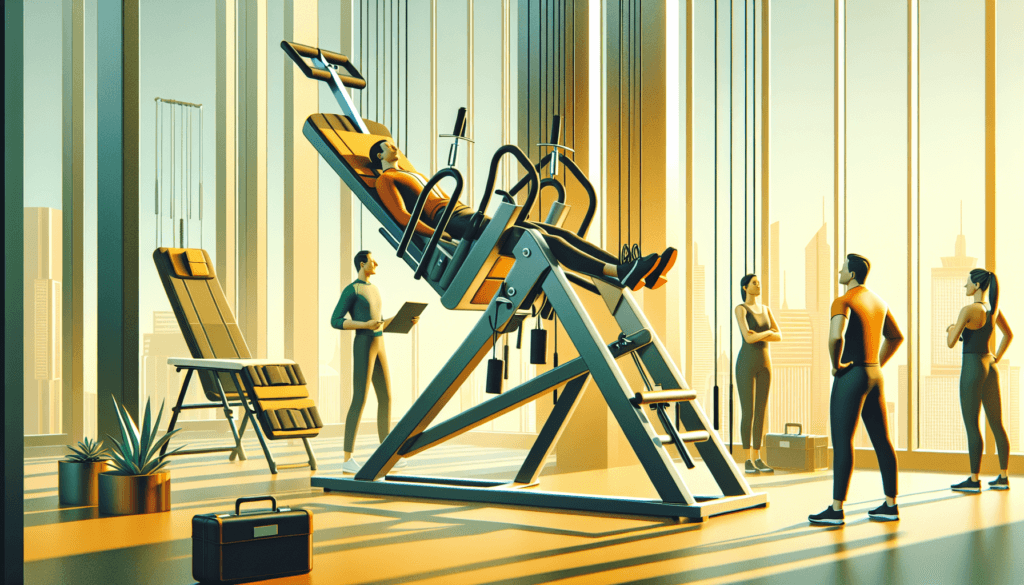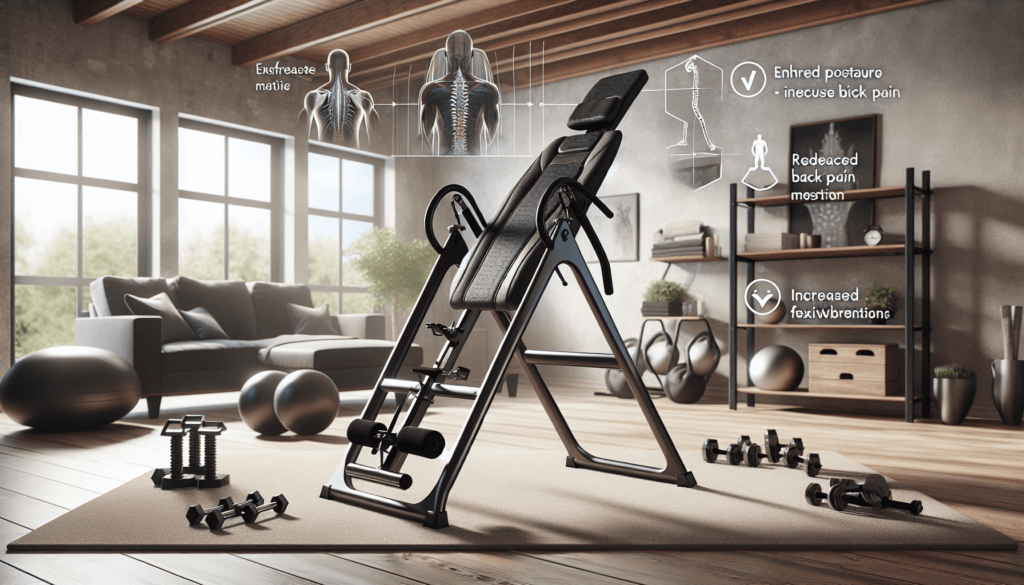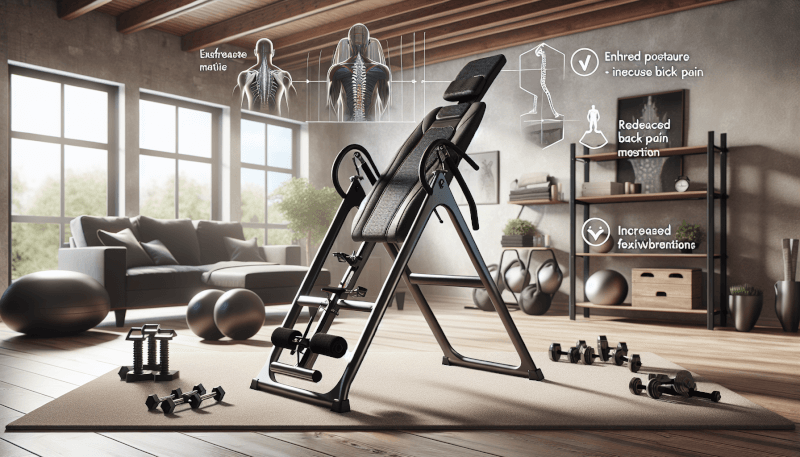Looking to take your fitness routine to new heights? Look no further than Fitness Gear Inversion Tables. These innovative pieces of equipment are designed to help you safely and effectively perform inversion exercises, which can improve flexibility, relieve back pain, and increase circulation. Whether you’re an experienced fitness enthusiast or just starting out, Fitness Gear Inversion Tables are a must-have addition to your home gym. So, get ready to soar to new levels of fitness and experience the incredible benefits of inversion therapy with Fitness Gear Inversion Tables.

What are Fitness Gear Inversion Tables?
Fitness Gear Inversion Tables are specially designed equipment that allow you to hang upside down or invert your body in order to relieve pressure on your spine and joints. This form of therapy, known as inversion therapy, has been used for centuries to alleviate back pain, improve circulation, and increase flexibility.
Definition of Fitness Gear Inversion Tables
Fitness Gear Inversion Tables are adjustable platforms with a padded bed and a sturdy frame, allowing you to securely invert your body at various angles. They typically have an ankle locking system that keeps you in place while inverted, ensuring your safety during the therapy.
Benefits of Using Inversion Tables
Using Fitness Gear Inversion Tables offers numerous benefits for your overall well-being. The inversion therapy provided by these tables helps decompress the spine, relieving pressure on the discs and promoting better spinal health. In addition, inversion therapy can help alleviate back pain, improve circulation, reduce muscle tension, and increase flexibility.
Different Types of Fitness Gear Inversion Tables
There are various types of Fitness Gear Inversion Tables to choose from, depending on your specific needs and preferences. Standard Inversion Tables are the most common type and provide a comfortable and secure platform for inverting. Gravity Boots are another option for those who prefer hanging upside down without the use of a table. Inversion Chairs offer an alternative sitting position for inversion therapy, providing additional support for the back. Teeter Hang Ups are a brand of inversion tables known for their high-quality and durability. Finally, Motorized Inversion Tables provide automated control for adjusting the inversion angle.
Factors to Consider Before Purchasing an Inversion Table
Before purchasing a Fitness Gear Inversion Table, there are several factors you should consider to ensure you choose the right one for your needs.
Budget
First and foremost, determine your budget for an inversion table. Prices can vary widely depending on the brand, features, and quality of the table. Set a budget that aligns with your financial capabilities to narrow down your options.
Space
Consider the available space in your home for setting up the inversion table. Measure the dimensions of the space where you plan to place the table to ensure it fits properly and allows for comfortable use.
Weight Limit
Check the weight limit of the inversion table to ensure it can safely support your body weight. It’s important to choose a table with a weight capacity that exceeds your own weight to prevent any potential accidents or damages to the equipment.
Adjustability
Look for an inversion table that offers adjustability in terms of its inversion angle. This will allow you to gradually increase or decrease the inversion angle as you progress in your therapy. Adjustable tables provide more versatility and customization options.
Comfort
Since you’ll be spending time in an inverted position, comfort is key. Look for an inversion table that has cushioning or padding on the bed to provide ample support and comfort for your back, shoulders, and neck.
Key Features of Fitness Gear Inversion Tables
Fitness Gear Inversion Tables come with a range of features designed to enhance your safety, ease of use, and overall comfort during inversion therapy.
Safety Features
One of the most important aspects of any inversion table is its safety features. Look for tables that have a secure ankle locking system to keep you in place while inverted. Some tables also have extra safety features such as adjustable straps or handles for added stability.
Ease of Use
Choose an inversion table that is easy to assemble and adjust. Look for tables that come with clear instructions and have user-friendly mechanisms for adjusting the inversion angle or locking system.
Size and Storage
Consider the size of the inversion table and whether it can be easily stored when not in use. Some tables fold or have a compact design, making them more convenient for those with limited space.
Ankle Locking System
The ankle locking system is a crucial feature to consider. It should securely hold your ankles in place while inverted, ensuring your safety and allowing you to relax during the therapy. Look for tables with adjustable ankle locks to accommodate different foot sizes.
Weight Capacity
Ensure that the inversion table you choose has a weight capacity that exceeds your own weight. This will ensure that the table is stable and can safely support your body during inversion therapy.
Adjustability
Having the ability to adjust the inversion angle is important for customization and progression in your therapy. Look for tables with multiple preset inversion angles or those that offer a wide range of adjustment options.
Padding and Comfort
Choose a table with sufficient padding or cushioning on the bed and other contact areas to provide maximum comfort during inversion. This will prevent discomfort or pressure points while you’re inverted.

Different Types of Fitness Gear Inversion Tables
There are several types of Fitness Gear Inversion Tables available, each with its own unique features and benefits.
Standard Inversion Tables
Standard inversion tables are the most common type and provide a comfortable and secure platform for inversion therapy. They typically come with adjustable inversion angles, ankle locking systems, and padded beds for added comfort.
Gravity Boots
For those who prefer hanging upside down without the use of a table, gravity boots are a good option. These boots attach to a bar or frame and allow you to hang freely. They require more upper body strength and coordination but offer a different inversion experience.
Inversion Chairs
Inversion chairs provide an alternative sitting position for inversion therapy. They are designed to provide additional support for the back and are ideal for people who have difficulty getting on and off traditional inversion tables.
Teeter Hang Ups
Teeter Hang Ups is a well-known brand of inversion tables known for their high-quality and durability. They offer a range of inversion tables with various features and customizable options.
Motorized Inversion Tables
Motorized inversion tables come with automated controls that allow you to easily adjust the inversion angle with the push of a button. These tables are ideal for those who prefer convenience and ease of use.
How to Use a Fitness Gear Inversion Table
Using a Fitness Gear Inversion Table involves several steps to ensure your safety and proper technique.
Setting up the Inversion Table
Start by setting up the inversion table in a designated area of your home. Follow the instructions provided with the table to assemble it properly. Ensure that the table is on a stable and level surface.
Adjusting the Angle
Before getting on the inversion table, adjust the inversion angle to a comfortable level. Start with a shallow or moderate angle if you’re new to inversion therapy and gradually increase it as you become more accustomed to the therapy.
Securing the Ankles
Once the desired inversion angle is set, secure your ankles in the ankle locking system. Make sure the ankle locks are tight enough to keep your feet in place but not too tight to cause discomfort or restrict blood circulation.
Inverting and Returning to an Upright Position
Gently lean back and allow the table to invert your body. Start with a short duration of inversion, such as a few minutes, and gradually increase the duration over time. To return to an upright position, use the handles on the table to pull yourself back up slowly and smoothly.
Safety Precautions
Always follow proper safety precautions when using an inversion table. Start with a low angle of inversion and listen to your body. If you experience any pain or discomfort, adjust the angle or stop the therapy. Avoid sudden movements or excessive twisting while inverted.
Benefits of Using Fitness Gear Inversion Tables
Using Fitness Gear Inversion Tables can provide a wide range of benefits for your physical and mental well-being.
Spinal Decompression
Inversion therapy helps decompress the spine by creating traction between the vertebrae. This relieves pressure on the discs and nerves, promoting better spinal health and reducing the risk of disc herniation or compression.
Relief from Back Pain
Inversion therapy is often used as a natural and non-invasive method to relieve back pain. By relieving pressure on the spine and promoting better alignment, inversion therapy can help alleviate chronic or acute back pain, including conditions such as sciatica or herniated discs.
Improved Circulation
Inverting the body allows for increased blood flow to the upper body and head, promoting better circulation. This can benefit brain function, cardiovascular health, and overall well-being.
Reduced Muscle Tension
Inversion therapy can help relax tense muscles and reduce muscle tension, particularly in the back, shoulders, and neck. By allowing the body to reverse the effects of gravity, muscle knots and tightness can be relieved.
Increased Flexibility
Regular use of an inversion table can improve flexibility by stretching the muscles and ligaments surrounding the spine. It can help lengthen the spine, improve joint mobility, and increase overall flexibility.
Risks and Precautions Associated with Using Inversion Tables
While inversion therapy can provide numerous benefits, it’s important to be aware of the potential risks and take proper precautions.
Consultation with a Healthcare Professional
Before starting inversion therapy, it’s recommended to consult with a healthcare professional, particularly if you have any pre-existing medical conditions or concerns. They can assess your suitability for inversion therapy and provide guidance on the appropriate usage.
Potential Health Risks
Inversion therapy is generally safe for most people, but there are certain health conditions that may contraindicate its use. These include high blood pressure, heart disease, glaucoma, pregnancy, and certain spinal conditions. Consult with a healthcare professional to determine if inversion therapy is safe for you.
Contraindications
In addition to specific health conditions, there are certain contraindications for using inversion tables. These include obesity, extreme obesity, recent surgery, and certain medications or medical treatments. Ensure that you are aware of any contraindications that may apply to you before using an inversion table.
Proper Technique and Form
Using proper technique and form is essential when using an inversion table. Follow the instructions provided with the table, start with a low angle of inversion, and listen to your body. Avoid sudden movements or excessive twisting while inverted, as this can put strain on the spine or cause injury.
Exercises to Perform on Fitness Gear Inversion Tables
In addition to providing spinal decompression and relieving back pain, Fitness Gear Inversion Tables can be used to perform various exercises to further enhance your fitness and well-being.
Stretching and Warm-Up Exercises
Inversion tables can be used to perform gentle stretching and warm-up exercises. These can include stretches for the back, shoulders, hips, and legs. Stretching on an inversion table can help improve flexibility and prepare the body for other exercises or physical activities.
Core Strengthening Exercises
The inverted position provided by an inversion table can be used to perform core strengthening exercises. These can include inverted crunches, leg raises, or oblique exercises. The resistance provided by gravity in this position can help enhance core strength and stability.
Inverted Yoga Poses
Inversion tables can also be used to perform inverted yoga poses. These can include poses such as the downward-facing dog, headstand, or shoulder stand. Inverting the body in these poses can provide additional benefits such as improved balance, focus, and relaxation.
Inverted Abdominal Exercises
Using an inversion table can also target the abdominal muscles. Inverted sit-ups or inverted bicycles are examples of exercises that engage the core and abdominal muscles while inverting. These exercises can help strengthen and tone the abdominal area.
Relaxation and Meditation
Finally, an inversion table can be a great tool for relaxation and meditation. Simply inverting and allowing yourself to relax in this position can help release tension and induce a sense of calm and relaxation. You can combine the inverted position with deep breathing exercises or guided meditation for even greater relaxation benefits.
Maintenance and Care Tips for Fitness Gear Inversion Tables
To ensure the longevity and optimal performance of your Fitness Gear Inversion Table, it’s important to take proper care and maintenance measures.
Regular Cleaning
Regularly clean the frame, bed, and other parts of the inversion table to prevent dirt, sweat, or dust buildup. Use a mild detergent and water to wipe down the surfaces, and dry them thoroughly before use.
Lubrication of Moving Parts
Check the moving parts, such as the hinges or joints, and apply lubrication as needed. This will ensure smooth and easy operation of the table. Always use the recommended type of lubricant specified in the manufacturer’s instructions.
Checking for Wear and Tear
Regularly inspect the inversion table for any signs of wear and tear, such as loose screws, frayed straps, or damaged padding. Address any issues promptly to prevent further damage or potential safety risks.
Storage Tips
When not in use, store the inversion table in a clean and dry area. If the table is foldable or has a compact design, make sure to properly fold or collapse it according to the manufacturer’s instructions. This will help save space and protect the table when not in use.
Conclusion
Fitness Gear Inversion Tables offer a convenient and effective way to relieve back pain, improve circulation, and increase flexibility. By choosing the right table for your needs and following proper usage guidelines, you can experience the numerous benefits of inversion therapy. Remember to consult with a healthcare professional before starting inversion therapy, especially if you have any pre-existing medical conditions. With regular use and proper care, a Fitness Gear Inversion Table can be a valuable addition to your fitness and wellness routine.


